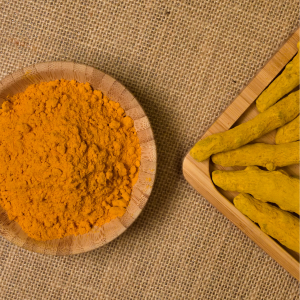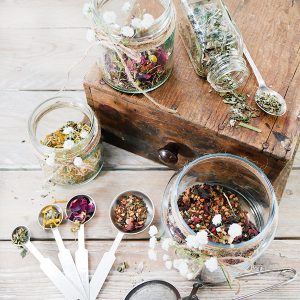From fighting nausea to aiding in digestion, ginger is a powerful plant that delivers results. In the same plant family as ginger sits turmeric, a root that aids with inflammation and controlling pain.
Alone, these plants contain dozens of benefits, but together their combined anti-inflammatory and immunity-boosting powers double in strength.
 What Are Turmeric and Ginger?
What Are Turmeric and Ginger?
Both turmeric and ginger are a part of the Zingiberaceae or ginger family. This collection of flowering plants all feature certain attributes, and for turmeric and ginger, those are it’s usable rhizome. The rhizome is a stem that grows deep into the ground and shoots off like roots, forming what we know as the ginger root though it is, in actuality, a plant stem and not the average root you would find with other flowering plants. These rhizomes possess all the anti-inflammatory and immunity-boosting goodness that we have come to know and love.
Together, ginger’s gingerol and turmeric’s curcumin combine into a powerful anti-inflammatory effect that actively helps to decrease pain and start building up your immune system. Nausea stands no chance for the stomach-settling prowess that both of these herbs possess. Simply put, combining turmeric and ginger together brings out the best qualities of both herbs. Drinking tea with turmeric and ginger is a taste sensation, while cooking a curry with these two spices will stimulate all your senses as well as keep you healthy.
Health Benefits of Turmeric and Ginger
Pain-Relieving
As was hypothesized by traditional Chinese medicine, turmeric and ginger can have pain-relieving effects for a variety of ailments. Curcumin, the superstar anti-inflammatory compound in turmeric, has been found to help relieve the symptoms of painful inflammatory diseases, like arthritis and colitis. For example, according to a 2021 review in Pharmaceutics, ginger seems to have a delayed therapeutic action, so it can be used for chronic pain—but might not be helpful for more acute pain, like from a headache. This same review noted that turmeric was shown to improve the quality of life and decrease pain in breast cancer patients undergoing chemotherapy.
Antioxidant-Rich
Ginger and turmeric are both excellent sources of protective compounds. The antioxidants found in ginger may help prevent heart disease and cancer, especially when paired with garlic. Turmeric packs even more of an antioxidant punch. There are several ways to assess antioxidant capacity, and each yields slightly different results. However, both turmeric and ginger are regarded as some of the most antioxidant-rich foods out there.
Anti-Inflammatory
Individually, ginger and turmeric both have impressive anti-inflammatory benefits. The compound in ginger, called gingerol, is responsible for its pungent flavor and many of its protective properties. There are several types of gingerol and other compounds in ginger that have been found to improve inflammatory conditions from a common cold to inflammatory bowel disease. A 2022 study in Frontiers in Pharmacology found that a compound in ginger called 6-shogaol was responsible for inhibiting inflammation in the cells of blood vessels.
Being from the same family of plants, turmeric is no exception. Curcumin is, again, center stage when it comes to anti-inflammation. A 2021 review in the Journal of the Science of Food and Agriculture cites study after study that shows all the various benefits of curcumin, including its amazing anti-inflammatory properties.
Like many classic food pairings, ginger and turmeric truly are better together. A 2022 study in the journal Molecules goes into depth about how the chemical compounds in both ginger and turmeric work to reduce inflammation in the body. These study authors state that because inflammation is a major contributing factor in many chronic diseases, including heart disease, diabetes, cancer and neurodegenerative diseases, they recommend combining ginger and turmeric for maximal benefits.
Heart-Healthy
Along with protecting your brain and muscles, these tuberous roots can help keep your heart healthy. High blood pressure can occur when plaque and platelets get stuck in your blood vessels. This increases the stress on your heart when it pumps blood, which increases your blood pressure.

Turmeric & ginger offer benefits for all aspects of cardiovascular health. With its high antioxidant levels, they help to protect the health of the heart and blood vessels by neutralizing free radicals before they can cause oxidative stress. Both turmeric and ginger also contain vitamins and minerals known to protect and promote cardiovascular health. Ginger may help to stimulate the heart muscle, and curcumin, the main constituent in turmeric, has shown potential to reduce age-related decline of the cells that make up the inner lining in blood vessels. As these cells play a part in many important bodily functions, such as forming new blood vessels, repairing organ damage, dilating and constricting the blood vessels and limiting blood clots, protecting these cells is highly beneficial to overall cardiovascular health.
Ginger has been found to lower blood pressure, according to a 2019 meta-analysis in Phytotherapy Research. When taken long term, turmeric can also have blood pressure-lowering effects, per a 2019 review in Pharmacological Research. And both ginger and turmeric may lower cholesterol, as well, according to a 2019 meta-analysis in Chemico-Biological Interactions.
Cancer-Blocking
The journal JCO Global Oncology published a 2018 study analyzing which spices may play a role in preventing cancer. Ginger and turmeric quickly came to the top of the list. They both block the formation of the known carcinogens nitrosamines and nitrosamides. These are the same compounds that caused people to become suspicious of nitrites in cured meats. Turmeric apparently boasts some additional benefits for smokers as well. The root helped cigarette smokers excrete the carcinogenic compounds that were dangerous to their health while also increasing protective compounds, like antioxidants, in the body. In light of all of the research about environmental toxins, fresh herbs and spices are a great protective addition to your plate.
Stomach-Soothing 
Ginger is a well-known home remedy for nausea, but how does the science stack up? Several studies have looked at why ginger soothes an upset stomach, and the consensus is that, in short, it works. Gingerol, the antioxidant compound in ginger, communicates with the serotonin (aka the “feel good” chemical) receptors in your brain to help relieve discomfort. This can have therapeutic implications for pregnant women and people on chemotherapy. For example, in a 2022 review published in the American Journal of Clinical Nutrition, researchers found that pregnant females who took ginger were 7.5 times less likely to experience nausea compared to those who took a placebo. In this same review, ginger also seemed to lower the likelihood of vomiting for people going through chemotherapy.
Immune-Supporting
Ginger is often recommended for a common cold, and the science is there to back it up, per a 2020 review in the International Journal of Health Sciences. A 2018 study in International Immunopharmacology found that the same compounds that give turmeric its anti-inflammatory benefits may protect you from influenza and pneumonia. And a 2020 study in the Journal of General Virology used curcumin against a gastrointestinal virus and found that it killed the virus. So it might be worth brewing some ginger-turmeric tea the next time you are feeling under the weather.
Turmeric Ginger for Circulation
The properties of turmeric ginger can be highly beneficial for poor circulation. Both turmeric and ginger have demonstrated effects that work to alleviate many potential causes of poor circulation. Turmeric ginger tea offers potent anti-inflammatory effects that can help to ease inflammation in the blood vessels and relax constriction, allowing for better blood flow.
Turmeric & ginger may also protect against plaque buildup due to its cholesterol countering effects. Turmeric has been shown to not only stimulate receptors of LDL (bad) cholesterol, which helps to clear it from the bloodstream, but also prevents its oxidisation, which is what forms plaque, due to its antioxidant strength. Ginger has also demonstrated an ability to reduce the count of LDL cholesterol in the bloodstream.
Ginger is well known for promoting healthy circulation, having a reputation as a warming herb due to its ability to increase blood flow to the extremities, making it fantastic addition for anyone suffering from chillblains or Raynaud’s disease. Ginger may reduce the risk of blood clotting, and contains several vitamins and minerals beneficial to circulation.
How to Use Turmeric and Ginger
Both turmeric and ginger can be found in most shops, sold as a whole root or powder. The powder has a longer shelf life than the whole roots. If you opt for the whole fresh roots, store them in a dry, dark place, such as a brown paper bag. Or my favourite is to pop them into the freezer and grate as needed into my dishes, this is as good as fresh and you don’t need to wait for it to defrost.

Turmeric and ginger are staple flavors for stir-fries, curries, stews, teas and much more. Both also make flavorful, tangy additions to smoothies, juices and of course golden milk or turmeric lattes. Medicinally they are available in dried powder, dried cut root, capsules, tinctures and teas. Turmeric is more brightly colored but milder in flavor than ginger. For this reason, turmeric should be used in larger amounts, and pungent, spicy ginger should be used more sparingly.
It’s worth noting, curcumin is difficult for our bodies to absorb on its own. Thankfully, it becomes better absorbed when paired with black pepper — so be sure to add a dash of pepper to your curries or golden milk.



 Hi, I’m Róisín Sheridan, founder and creator of HealthTea. My 3 main passions in life are people, nature and health, although not always in that order...
Hi, I’m Róisín Sheridan, founder and creator of HealthTea. My 3 main passions in life are people, nature and health, although not always in that order... 



